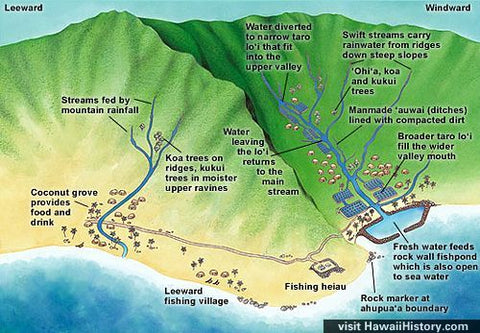The System Behind Hawai`i's Success | Hawai`i's Roots - Episode 1
Aloha,
Mahalo for joining Kaunamano Farm! Here at Kaunamano, it is our goal to rebuild Hawai`i's food resiliency into the beautiful, sustainable system it once was, and we are thrilled that you are interested in learning more about this mission.
Before we can build this future, however, it is crucial we understand where we came from and learn from those who came before us. To do this, we have composed a three-part, introductory newsletter called Hawai`i's Roots, with each letter covering a different period of time in Hawai`i’s agricultural history. It is with this introduction that we hope you will be better prepared to make a difference in Hawai`i's agriculture, and you will understand why making that difference is crucial for the future of our communities.
Today, we start from the beginning.
When Polynesian settlers first set their eyes upon the Hawaiians Islands 1700 years ago, one can only imagine the thoughts that raced through their minds. No doubt they marveled at the majestic beauty of the island’s coastlines and mountains, stunned that they had come across such islands in the vast expanse of the Pacific Ocean, thousands of miles away from the nearest landmass. As they explored the islands, however, another question likely came creeping in: “How are we going to survive?” The settlers knew that whomever decided to stay on the islands would need to devise a method of self-sufficiency unique to the island’s geography and isolation. While most of Earth’s people at the time had vast expanses of land and animals to choose from, the Polynesians were extremely limited, and therefore had no choice but to be both creative and provident. The result? The ahupua`a system (shown below).
The ahupua`a system consisted of dividing the mokupuni (islands) into moku (wedges of land) stretching from mountaintops down to the coastline. These moku were further split into ahupua`a (smaller wedges) and ruled by an ali`i, or chief. Each ahupua`a provided everything the native Hawaiians needed to survive, whether it be fish from the sea, fertile soil to plant taro, or koa and other trees to craft into buildings, canoes, and tools. To ensure proper stewardship of these lands, konohiki (overseers) were assigned to watch over the moku’s operations and retrieve weekly and yearly taxes from the land’s inhabitants for the ali`i.
Over time, this stewardship was formalized through the kapu system, which placed restrictions such as limited fishing in certain locations and the gathering and replacing of plants. The system’s division of labor effectively produced enough to sustain entire communities of Hawaiian people for generations, and simultaneously allowed for a relatively high quality of life. In their spare time, Hawaiians devoted themselves to arts and crafts, competitive sport, martial arts, and dance and chant, creating many rich traditions that continue to thrive today.
Over the course of its existence, the ahupua`a system was refined and optimized, providing the core foundation for the Hawaiian people to prosper as a developing nation for over a thousand years. Many things contributed to the system’s success, but one component is impossible to overlook: symbiosis. Ancient Hawaiians understood that each and every element of their ecosystem was interconnected. How much was taken from the forest influenced how much food could be grown, and vice versa. The land affected the sea, and the sea the land. It was only with respect for this fact that proper stewardship could ensue.
As Hawai`i became more globally connected, it became more and more difficult to maintain this symbiosis, and Hawai`i entered a transformative time for both the land and its people. This is what we cover in the next episode of Hawai`i's Roots, found here.
Mahalo for Eating With Impact,
- Kaunamano Farm